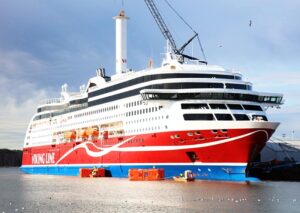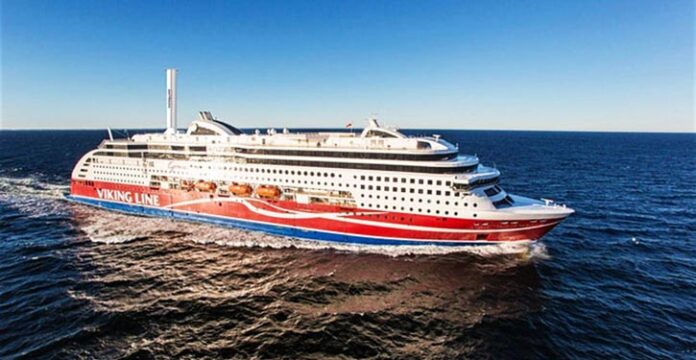In mid of April 2018 the M/S VIKING GRACE sets sail on her first voyage as the only passenger ship in the world equipped with a Rotor Sail to harness wind power for propulsion. Developed by Finnish clean technology and engineering company Norsepower Oy Ltd., the Rotor Sail Solution will cut, according to the company, fuel consumption by around 300 to yearly and reduce carbon emissions (CO2) by up to 900 tonnes annually. Viking Line operates the VIKING GRACE on wind-assisted voyages between Turku (Finland) and Stockholm (Sweden) since April 12th 2018.
The cylindrical Rotor Sail unit installed on this vessel is 24m in height and 4m in diameter, and is a modernised version of the Flettner rotor; a spinning cylinder that uses the Magnus effect to harness wind power to propel a ship. The solution is fully automated and senses whenever the wind is strong enough to deliver fuel savings, at which point the rotors start automatically – optimising crew time and resource.

The use of wind power reflects the green values of Viking Line. The natural environments of the sea and the archipelago are close to the heart of the shipping company based in the Åland Islands. In operation since 2013, the VIKING GRACE is one of the most environmentally friendly passenger ships in the world: it is fuelled with Methane (Natural Gas) and has very low emissions and noise levels. The new Rotor Sail will only boost her already impressive environmental credentials.
Commenting on the partnership, Jan Hanses, CEO, Viking Line, said: “This is a great day for us. As an Åland shipping company, we rely on the sea for our livelihood so it’s of prime importance for us to promote the well-being of the marine environment. We want to pioneer the use of solutions that reduce the environmental load. Based in Finland, Norsepower has developed a world-class mechanical Rotor Sail Solution that will reduce fuel consumption. We are proud of the fact that our VIKING GRACE will be the first passenger ship in the world to benefit from this innovative solution.”
The basic design and idea of the Flettner rotor has been around for over 90 years. However, with the rise of environmental regulations, the concept of rotor sails has gained much interest in the global maritime community. This is further fuelled by the advancements in manufacturing, material and technological solutions. Norsepower is years ahead of other players in this space and is recognised as the first commercial provider of auxiliary wind propulsion for shipping.
Tuomas Riski, CEO of Norsepower said: “For Norsepower, it’s an honour to contribute to making the M/S VIKING GRACE even more environmentally-friendly by means of our novel Rotor Sail technology. The last traditional windjammers in the world were owned and operated by shipping companies based in Åland, so it’s only fitting that Åland-based Viking Line should be a forerunner in launching modern auxiliary sail technology. Viking Line and Norsepower have collaborated in an excellent manner in retrofitting the Rotor Sail solution on the VIKING GRACE, and the completion of this project is a great moment for all those involved.”
In addition to the installation onboard the VIKING GRACE, Viking Line will also install two Norsepower Rotor Sails onboard a newbuild cruise ferry vessel which is currently being built in China and due to be operational in 2020.
This project has received funding from the European Union’s Horizon 2020 research and innovation programme under grant agreement No 738282.




